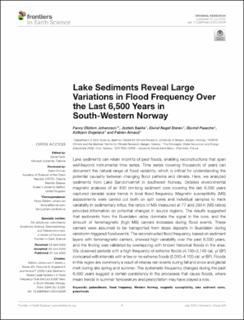| dc.contributor.author | Ekblom Johansson, Fanny Maria | |
| dc.contributor.author | Bakke, Jostein | |
| dc.contributor.author | Støren, Eivind Wilhelm Nagel | |
| dc.contributor.author | Paasche, Øyvind | |
| dc.contributor.author | Engeland, Kolbjørn | |
| dc.contributor.author | Arnaud, Fabien | |
| dc.date.accessioned | 2021-06-28T10:32:08Z | |
| dc.date.available | 2021-06-28T10:32:08Z | |
| dc.date.created | 2020-06-06T13:39:02Z | |
| dc.date.issued | 2020 | |
| dc.identifier.issn | 2296-6463 | |
| dc.identifier.uri | https://hdl.handle.net/11250/2761588 | |
| dc.description.abstract | Lake sediments can retain imprints of past floods, enabling reconstructions that span well-beyond instrumental time series. Time series covering thousands of years can document the natural range of flood variability, which is critical for understanding the potential causality between changing flood patterns and climate. Here, we analyzed sediments from Lake Sandvinvatnet in southwest Norway. Detailed environmental magnetic analyses of an 830 cm-long sediment core covering the last 6,500 years captured decadal scale trends in local flood frequency. Magnetic susceptibility (MS) assessments were carried out both on split cores and individual samples to track variability in sedimentary influx; the ratios of MS measured at 77 and 293 K (MS ratios) provided information on potential changes in source regions. The results suggested that sediments from the Buerdalen valley dominate the signal in the core, and the amount of ferromagnetic (high MS) carriers increases during flood events. These carriers were assumed to be transported from slope deposits in Buerdalen during rainstorm-triggered flood events. The reconstructed flood frequency, based on sediment layers with ferromagnetic carriers, showed high variability over the past 6,500 years, and the finding was validated by overlapping with known historical floods in the area. We observed periods with a high frequency of extreme floods (4,100–3,140 cal. yr BP) compared with intervals with a few or no extreme floods (6,050–4,100 cal. yr BP). Floods in this region are commonly a result of intense rain events during fall and snow and glacial melt during late spring and summer. The systematic frequency changes during the past 6,500 years suggest a certain persistency in the processes that cause floods, where mean trends in summer temperature and precipitation may have played a role. | en_US |
| dc.language.iso | eng | en_US |
| dc.publisher | Frontiers Media | en_US |
| dc.rights | Navngivelse 4.0 Internasjonal | * |
| dc.rights.uri | http://creativecommons.org/licenses/by/4.0/deed.no | * |
| dc.title | Lake Sediments Reveal Large Variations in Flood Frequency Over the Last 6,500 Years in South-Western Norway | en_US |
| dc.type | Journal article | en_US |
| dc.type | Peer reviewed | en_US |
| dc.description.version | publishedVersion | en_US |
| dc.rights.holder | Copyright 2020 Ekblom Johansson, Bakke, Støren, Paasche, Engeland and Arnaud | en_US |
| dc.source.articlenumber | 239 | en_US |
| cristin.ispublished | true | |
| cristin.fulltext | original | |
| cristin.qualitycode | 1 | |
| dc.identifier.doi | 10.3389/feart.2020.00239 | |
| dc.identifier.cristin | 1814181 | |
| dc.source.journal | Frontiers in Earth Science | en_US |
| dc.relation.project | Norges forskningsråd: 267719 | en_US |
| dc.identifier.citation | Frontiers in Earth Science. 2020, 8, 239. | en_US |
| dc.source.volume | 8 | en_US |

